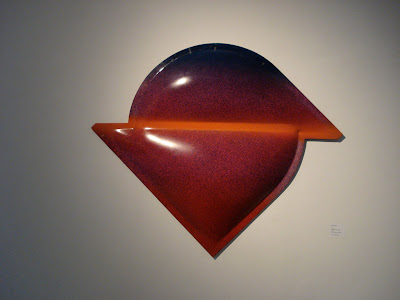Sunday, September 26, 2010
TIME OFF
Saturday, September 25, 2010
BIG DAY AT LACMA











Louis


Thursday, September 23, 2010
HARVEST MOON...
Wednesday, September 22, 2010
Don't Ask...
Pedestal (and Other) Pieces
 There's definitely something "retro" about these figures, recalling the decorative styles of the mid-20th century. There's a touch of charming innocence about them that I like, a refusal to be cowed by the mainstream's fear of having fun with pattern and color. Their optimistic energy is a welcome relief, at this moment in our history, to a social, cultural and political climate that seems to be driving us at breakneck speed toward the abyss.
There's definitely something "retro" about these figures, recalling the decorative styles of the mid-20th century. There's a touch of charming innocence about them that I like, a refusal to be cowed by the mainstream's fear of having fun with pattern and color. Their optimistic energy is a welcome relief, at this moment in our history, to a social, cultural and political climate that seems to be driving us at breakneck speed toward the abyss. Including both pedestal and large-scale wall pieces, these over-the-top works comprise a bit of everything, from current political satire to references to ancient Aztec deities, from the kind of Chicanismo represented by tag art, murals and low-riders to folk art, retablos, and the long tradition of Catholic hagiography. So far as I can tell, the brothers employ a whole range of media, from the multi-colored blown glass that predominates in these works to found objects and photography. It's a huge, joyful, uninhibited dance with color and energy, broad humor and polemic, eclectic form and global content, body, soul and spirit which includes the viewer in its passionate embrace of life--and art.
Including both pedestal and large-scale wall pieces, these over-the-top works comprise a bit of everything, from current political satire to references to ancient Aztec deities, from the kind of Chicanismo represented by tag art, murals and low-riders to folk art, retablos, and the long tradition of Catholic hagiography. So far as I can tell, the brothers employ a whole range of media, from the multi-colored blown glass that predominates in these works to found objects and photography. It's a huge, joyful, uninhibited dance with color and energy, broad humor and polemic, eclectic form and global content, body, soul and spirit which includes the viewer in its passionate embrace of life--and art.
Micaela Amateau Amato, "Exiles & Nomads" Cameroon figure with yellow hands, 2010. Cast glass on welded steel base, 17 x 11 x 9-1/2 inches and ceramics... |
Micaela Amateau Amato, "Exiles & Nomads"
Ceramic figure with bent body-pink face, 2009. Glazed ceramic, 11 x 7 x 9 inches
... to create works that "symbolize people across the globe who have suffered the brutalities of war and tribal ethnic cleansing." The expressions and postures of these small heads and figurines are as eloquent as the glazes Amato employs to suggest distortion, dislocation, fracture and dismemberment. Their references to art historical precedent--from Egyptian funerary sculpture to Mexican santos, tribal African carving and Japanese butoh performers-- remind us that the human diaspora of the 21st century has become a world-wide and sometimes agonizingly problematic phenomenon, as the global climate continues to change and resources deplete. This work is about the commonality of human suffering, human survival and the dignity of the human spirit in a world where religious and cultural differences threaten to become even more destructively divisive. It reminds us that art is still one place where we all can come together.




and finally Amir H. Fallah's Terminated, 2008, acrylic, watercolor, ink, collage and pencil on paper mounted on canvas, 84 x 60 inches:

The raw quality of image, the sometimes garish color, the dream-like vacancy... all these contribute to the un-ease of these paintings, the dis-quiet with which they leave us. Thanks for joining me on this tour.
Tuesday, September 21, 2010
Mad Men
DISTORTION
Monday, September 20, 2010
TED Talk
Sunday, September 19, 2010
MAD HATTERS...
LEAD EDITORIAL--NYT
The Secret Election
Published: September 18, 2010
For all the headlines about the Tea Party and blind voter anger, the most disturbing story of this year’s election is embodied in an odd combination of numbers and letters: 501(c)(4). That is the legal designation for the advocacy committees that are sucking in many millions of anonymous corporate dollars, making this the most secretive election cycle since the Watergate years.
Related
Times Topic: Campaign Finance
As Michael Luo reported in The Timeslast week, the battle for Congress is largely being financed by a small corps of wealthy individuals and corporations whose names may never be known to the public. And the full brunt of that spending — most of it going to Republican candidates — has yet to be felt in this campaign.
Corporations got the power to pour anonymous money into elections from Supreme Court and Federal Election Commission decisions in the last two years, culminating in the Citizens United opinion earlier this year. The effect is drastic: In 2004 and 2006, virtually all independent groups receiving electioneering donations revealed their donors. In 2008, less than half of the groups reported their donors, according to a study issued last week by the watchdog group Public Citizen. So far this year, only 32 percent of the groups have done so.
Most of the cash has gone to Republican operatives like Karl Rove who have set up tax-exempt 501(c)(4) organizations. In theory, these groups, with disingenuously innocuous names like American Crossroads and the American Action Network, are meant to promote social welfare. The value to the political operatives is that they are a funnel for anonymous campaign donations.
Mr. Rove’s group, American Crossroads, hopes to spend $50 million, and is already advertising against Democratic candidates in California, Pennsylvania, Nevada and other states. The American Action Network, led by Norm Coleman, the former Republican senator from Minnesota, is spending $25 million, and has been blasting the Democratic senators Patty Murray in Washington and Russell Feingold in Wisconsin.
The United States Chamber of Commerce, still boiling over its failure to stop health care reform, is spending $75 million to defeat the lawmakers who approved it. Their donors need not be revealed. (Labor unions are trying to do the same thing for Democrats, but cannot raise nearly as much money.)
The new secrecy era began with the 2007 Supreme Court decision in the Wisconsin Right to Life case, which tore away federal restrictions on corporate and union political spending in the weeks just before an election. The F.E.C. interpreted that decision to mean that unless an ad explicitly said “elect John Doe” (as if that matters), corporate donors did not have to be disclosed.
Then the Citizens United decision fully legalized such donations under the First Amendment. That new protection has led to the flourishing of the (c)(4) groups, which know they will not be investigated by a deadlocked F.E.C. or an Internal Revenue Service that has bigger issues to deal with.
The Citizens United decision, paradoxically, supported greater disclosure of donors, but Senate Republicans have filibustered a bill that would eliminate the secrecy shield. Just one vote is preventing passage. That act is coming back for another Senate vote. The two Republican senators from Maine, Susan Collins and Olympia Snowe, might want to read a recent poll by the Maine Citizens for Clean Elections, which showed that 80 percent of the state’s voters support public disclosure.
It is too late for a new law to have any effect on the dark swamp of this year’s elections, but there is still hope that Congress will allow the sun to shine on the elections of 2012 and beyond.
THE BUDDHA DIARIES apologizes to The New York Times for stealing their editorial today.
Please go back to my Manifesto and consider joining me. Otherwise, we're all screwed... Forgive the un-Buddhist language.
Saturday, September 18, 2010
RALLY TO RESTORE SANITY

Friday, September 17, 2010
"The Call"
The Lowest Form of Humor
Thursday, September 16, 2010
My TEDx Talk
Roland Reiss

Wednesday, September 15, 2010
The Motor Bus
- What is this that roareth thus?
- Can it be a Motor Bus?
- Yes, the smell and hideous hum
- Indicant Motorem Bum!
- Implet in the Corn and High
- Terror me Motoris Bi:
- Bo Motori clamitabo
- Ne Motore caedar a Bo---
- Dative be or Ablative
- So thou only let us live:---
- Whither shall thy victims flee?
- Spare us, spare us, Motor Be!
- Thus I sang; and still anigh
- Came in hordes Motores Bi,
- Et complebat omne forum
- Copia Motorum Borum.
- How shall wretches live like us
- Cincti Bis Motoribus?
- Domine, defende nos
- Contra hos Motores Bos!












.jpg)







